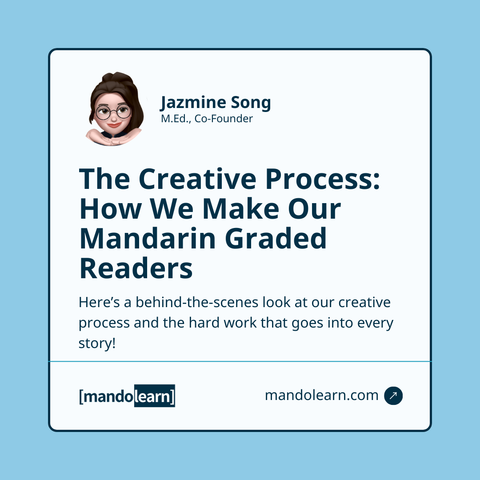Every book we publish is the result of hours of brainstorming, writing, editing, and formatting—all done by just the two of us. It’s a labor of love, and we take pride in every step. In this post, we want to take you behind the scenes of how we bring MandoLearn graded readers to life, from the very first idea to the moment we click “publish.”
1. The Initial Idea: Where It All Starts
💡Every story starts with an idea, and most of those ideas come from Song. When he’s not working or brainstorming with me, you’ll find him reading manga, which is often where the inspiration hits. He has a knack for coming up with creative plots full of twists and turns that keep me hooked, even when I’m just listening to his initial pitch.
Not all of his ideas make the cut, though. While some are instant hits, others… not so much. (Let’s just say there’s a reason we don’t have a story from the perspective of a turtle... 🐢)
We try to pick themes that resonate with learners—things like travel, cross-cultural friendships, food, or life in Asia... (maybe not turtles). These are topics we’ve noticed language learners enjoy, based on my experience as a learner and Song’s experience teaching Chinese.
2. Story Development: From Idea to Outline
Once we have a solid concept, we outline the story with the language level in mind. Certain ideas, like a complex wuxia adventure, just aren’t feasible for a Level 1 book because they require too much technical language.
Song works out the plot and starts drafting, relying heavily on the new HSK vocabulary lists, which we practically have memorized at this point. (Seriously, we could probably recite which words belong to HSK 1 and HSK 2 by heart!)
When Song finishes the first draft, I usually come in with a fresh perspective. I can spot the parts that are too difficult for the target level—something that’s easier for me because I still think like a learner sometimes. This is when the “fun” part begins: revising and simplifying until the story flows naturally and fits the level.
3. Language Level Design: Sticking to the HSK
The new HSK standards are the backbone of our process. We use the official character, vocabulary, and grammar lists as a guide to make sure everything is level-appropriate and consistent.
Balancing a good story with language simplicity is one of the hardest parts of the process. We use lots of dialogue, creative punctuation, and clear context to get the point across without overwhelming learners with new vocabulary or long descriptions. If we absolutely need to introduce a new word, we make sure it’s important to the plot, and we reinforce it many times.
This also means constant tweaking and second-guessing. It’s not uncommon for us to pause mid-edit and say, “Wait, this word is in HSK 4. We need to change it.” It’s a lot of work, but it’s worth it to create books that truly help learners progress.
4. Popups and Audio: Bringing the Story to Life
Clickable Popups: Creating the popups is a time-consuming but essential part of the process. First, we manually go through each chapter to identify words that are above the book’s level. This is the only part of the process where we use ChatGPT to generate pinyin, zhuyin, and definitions. Finally, we double-check everything manually to make sure the definitions are accurate and the pinyin matches the correct tone.
Once that’s done, we format everything by hand to make the words clickable. It’s not glamorous, but it’s a feature we know learners really appreciate.
Recording Audio: Recording audio is another step we handle ourselves. For the China version, Song sets up a professional microphone in a closet (with a blanket for soundproofing). For the Taiwan version, we rent a recording studio and work with a voice artist. The process can be a bit exhausting, but hearing the final audio always makes it feel worthwhile.
5. Team Collaboration: How We Work Together
Creating a book is truly a team effort. Here’s how we divide the work:
- Song takes charge of plotting, outlining, and writing the first draft.
- I focus on the website, designs, audio editing, and social media.
- Both of us handle the editing and proofreading together.
- Art and Taiwan voiceovers are handled by professionals in their craft.
6. Challenges and Lessons Learned
Nothing ever goes exactly as planned. There are days when we work long hours only to hit a roadblock, or when technical issues (like accidentally deleted files) throw everything off track. Balancing work, life, and creativity can be tough.
But every challenge teaches us something. Like the time an entire chapter had to be rewritten because it was way too complicated for the target level. It was frustrating, but it reminded us why we care so much about getting this right.
7. Pride in Our Process: Why We Do It
The best part of the entire process is seeing our finished books out in the world. Seeing the cover online is always satisfying, but nothing compares to the emails and feedback we get from readers. ❤️
We pour so much into every book we create, and clicking “publish” is one of the most exciting feelings ever. Knowing that learners are enjoying our stories and using them to improve their Mandarin makes it all worthwhile.
Final Thoughts
Creating Chinese-graded readers is challenging, but it’s also deeply rewarding.
Thank you for supporting us on this journey. We couldn’t do it without you!
⬇️ What surprised you the most about our creative process? Let us know in the comments!





Comments (0)
There are no comments for this article. Be the first one to leave a message!